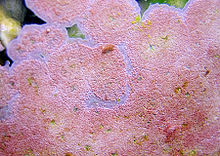Coralline algae
| Coralline algae Temporal range: Early Cretaceous–recent |
|
|---|---|
 |
|
 |
|
| Spongites yendoi together with the gardening limpet Scutellastra cochlear | |
| Scientific classification | |
| (unranked): | Archaeplastida |
| Division: | Rhodophyta |
| Class: | Florideophyceae |
| Subclass: | Corallinophycidae |
| Order: |
Corallinales Silva & Johansen, 1986 |
| Families and subfamilies | |
|
|
Coralline algae are red algae in the order Corallinales. They are characterized by a thallus that is hard because of calcareous deposits contained within the cell walls. The colors of these algae are most typically pink, or some other shade of red, but other species can be purple, yellow, blue, white or gray-green. Coralline algae play an important role in the ecology of coral reefs. Sea urchins, parrot fish, limpets (mollusks), and chitons (mollusks), feed on coralline algae. In the temperate Mediterranean sea, coralline algae are the main builders of a typical algal reef, the Coralligène (=coralligenous). Many are typically encrusting and rock-like, found in marine waters all over the world. Only one species lives in freshwater. Unattached specimens (maerl, rhodoliths) may form relatively smooth compact balls to warty or fruticose thalli.
A close look at almost any intertidal rocky shore or coral reef will reveal an abundance of pink to pinkish-grey patches, splashed as though by a mad painter over rock surfaces. These patches of pink "paint" are actually living algae: crustose coralline red algae. The red algae belong to the division Rhodophyta, within which the coralline algae form the order Corallinales. There are over 1600 described species of nongeniculate coralline algae.
The corallines are presently grouped into two families on the basis of their reproductive structures.
Coralline algae are widespread in all of the world's oceans, where they often cover close to 100% of rocky substrata. Only one species, Pneophyllum cetinaensis, is found in freshwater. Many are epiphytic (grow on other algae or marine angiosperms), or epizoic (grow on animals), and some are even parasitic on other corallines. Despite their ubiquity, the coralline algae are poorly known by ecologists, and even by specialist phycologists (people who study algae). For example, a recent book on the seaweeds of Hawaii does not include any crustose coralline algae, even though corallines are quite well studied there and dominate many marine areas.
...
Wikipedia
